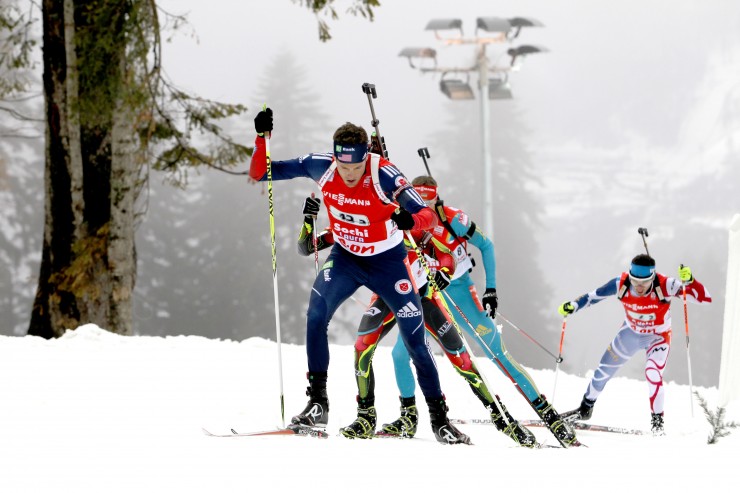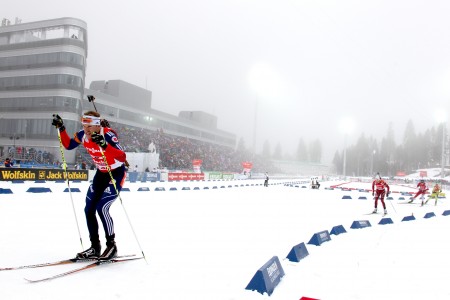
In their last race on the Olympic courses before next year’s Games, the U.S. men’s biathlon team placed tenth in Sunday’s relay – but only barely. Anchor skier Leif Nordgren missed out on eighth place by just a few hundredths of a second, losing a photo finish to Matej Kazar of Slovakia.
“I pulled even with him in the last 10 meters, and I had actually thought I got him at the line,” Nordgren wrote in an e-mail. “They put us ahead for about 10 minutes, but then they changed it and I’m not sure why. They wouldn’t let us look at the sprint photo so I thought it was a little sketchy. But oh well.”
The result could probably be classified as the same way that Nordgren described his own race: “okay, not good, not bad.” Things had seemed particularly promising early on, with typically excellent legs by leadoff racer Lowell Bailey and then Tim Burke.
Bailey had used a single spare round and then caught back up to the leaders, and tagged off in fourth place, 4.7 seconds behind the leading team.
That set the stage for Burke, who had already proved that he liked the Sochi courses when he placed fifth in the individual race on Thursday. Using a single spare round of his own, he held that position and finished his 7.5 k leg with almost exactly the same deficit that Bailey had.
“I was happy with my race,” Burke told FasterSkier. “Lowell tagged me in a really good spot, right up there with the leaders. And to have one spare round is good for me.”

After Russell Currier struggled in standing, using three spare rounds but managing to avoid the penalty loop, the team was stuck in tenth. Nordgren managed to cimb up to ninth when he left the range after standing, but Kazar was hot on his heels.
“I left on the last loop about 5 or 6 seconds in front of Kazar,” Nordgren explained. “He didn’t gain too much on me on the hill, but on the back part of the course he reeled me in, at that point I started conserving a little knowing it would be a sprint finish. He passed me with about 300 meters to go, but I was fine with that. Going into the last 150 meters the snow totally changed into really soft slow snow, I wasn’t really expecting that, so it took me a little longer to get my sprint going.”
Nordgren said that it was the best he had felt skiing in several days; the men also noted that organizers had finally decided to salt the uphills, which made things faster and was a welcome change.
It wasn’t an excellent week for most of the team, but Bailey said that he was fairly happy with his results, including 47th in the individual and 30th in the sprint.
“I was hoping for a little bit better results this week after a frustrating mass start in Oslo,” he said. “Lately, it seems I’ve been able to put together mostly good races with just one slip up here or there. But, overall, I’m satisfied with a tough week of racing. I felt really good in the 20 k here, on a course doesn’t necessarily play to my strong points – huge climbs with little in the way of transitions and gradual terrain.”
Regarding the sprint, he said, “I’ll take a top-30 any day!”
One recurring theme when talking to the team was the worry that when they fly back next year for the Olympics, things might be very different. There’s the obvious things – roads and buildings unfinished, that hopefully will look shiny and new next winter.
“They have a lot of work to do between now and then,” Bailey said. “Right now, the village and the dining facilities are about halfway there and the venues has a ways to go.”
But there’s also the matter of racing. Although the venue had hosted a smaller, non-World Cup test race earlier this season, there were a lot of complaints about the difficulty of the courses, organizers made some changes for the relays.
The downhills were particularly treacherous, and the most dangerous one was cut out. Bailey said that with the race run the way it was, the scramble leg was not nearly as scary as he and the other men had mentally prepared themselves for.
“I was definitely concerned about the first turn in a mass start situation, but apparently, a lot of other people were as well,” he wrote. “This morning we were informed that they changed the course and altered that turn to make it much less severe. The result was a course that skied much better and had a decent flow to it. The rumors circulating now
are that the Sochi Organizing Committee will change significant portions of the course before the Olympics. I think this is a great move.”

Changes would definitely be welcome, in one sense.
“A few technical descents are pretty dangerous depending on the type of snow,” Nordgren said. “I saw quite a few broken stocks in the individual, and there have been a lot of crashes all week.”
But he also noted that the changes for the relay, in order to cut out one downhill, had also removed one uphill, and he missed it. Personally, he had liked the course’s big climbes, which will cater to the toughest skiers.
And Burke also said that additional changes will have a downside. It’s entirely possible that when teams arrive for the Olympics, they will encounter courses that are different from the ones that they tested this week. That to some degree defeats the purpose of having a World Cup prior to the Games – although it’s the place when these lessons are learned, the point is that athletes can get to know the trails.
“I think [changes are] needed, but at the same time it is a little disappointing that we will not get a chance to ski on these changes until the Olympics,” Burke said.
It’s an inevitable challenge given that Olympic Games are rarely held on pre-existing trails that are a regular stop on the World Cup circuit. So would requiring more progress earlier, and two years of test events, help?
Burke wasn’t sure.
“I think one test event is enough for the athletes, if the course is indeed the same for the Olympics,” he said. “I feel like once I have a few races on one course, I know how I need to prepare for that course in the future. It is more important for the ski technicians to spend time at the venue. I know our guys have been here quite a bit testing grinds, and I know they will continue that right up until the start of the Games.”
And in that capacity, the week was incredibly useful. Athletes encountered at least three completely different types of snow conditions: hard and fast on Thursday, soft and slushy on Saturday, and salted uphills on Sunday.
“This week we definitely learned that the conditions here can change fast,” Burke said. “This will not be one of those venues where athletes will be using the same ski/wax combination for the entire two weeks. Because of that, I think the service teams will play even a bigger role in next years Olympics. I think we have one of the best ski service teams in the world. These guys prove that every week, so I am very confident that they will get the job done next year.”
Chelsea Little
Chelsea Little is FasterSkier's Editor-At-Large. A former racer at Ford Sayre, Dartmouth College and the Craftsbury Green Racing Project, she is a PhD candidate in aquatic ecology in the @Altermatt_lab at Eawag, the Swiss Federal Institute of Aquatic Science and Technology in Zurich, Switzerland. You can follow her on twitter @ChelskiLittle.




2 comments
nyctvt
March 11, 2013 at 9:43 am
They should also look at the relay tag zone and the lead in to it. Because of the long straight lead in to the tag zone the athletes came into it with a lot of speed. When several athletes were coming in at the same time they could not get out of each others way. Saw several crashes in the tag zone and it look like one athlete got hurt.
dima
March 11, 2013 at 4:35 pm
I agree the tag zone was way too short/narrow for the speed coming down the hill, especially considering the way the track were set up it kept most of the field really close, in 1 or 2 groups, through the whole race (not usually the case) & they were tagging off within seconds of each other.